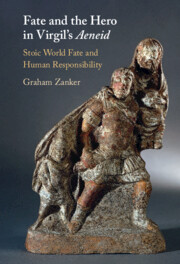Book contents
- Fate and the Hero in Virgil’s Aeneid
- Fate and the Hero in Virgil’s Aeneid
- Copyright page
- Dedication
- Contents
- Preface
- Abbreviations
- Introduction
- Chapter 1 Stoic World Fate and Virgil’s Aeneid
- Chapter 2 Fate and the Human Responsibility of Dido and Aeneas in Aeneid 4: A Case Study
- Chapter 3 Stoic World Fate and the Gods of the Aeneid
- Chapter 4 Stoic World Fate and the Humans of the Aeneid
- Chapter 5 Stoic World Fate and Roman Imperium in the Aeneid: Tragedy and Didacticism
- Book part
- References
- Index Locorum
- Index
Chapter 2 - Fate and the Human Responsibility of Dido and Aeneas in Aeneid 4: A Case Study
Published online by Cambridge University Press: 06 April 2023
- Fate and the Hero in Virgil’s Aeneid
- Fate and the Hero in Virgil’s Aeneid
- Copyright page
- Dedication
- Contents
- Preface
- Abbreviations
- Introduction
- Chapter 1 Stoic World Fate and Virgil’s Aeneid
- Chapter 2 Fate and the Human Responsibility of Dido and Aeneas in Aeneid 4: A Case Study
- Chapter 3 Stoic World Fate and the Gods of the Aeneid
- Chapter 4 Stoic World Fate and the Humans of the Aeneid
- Chapter 5 Stoic World Fate and Roman Imperium in the Aeneid: Tragedy and Didacticism
- Book part
- References
- Index Locorum
- Index
Summary
The figures of Dido and Aeneas in Aeneid 4 illustrate how Virgil adopts Stoic belief in human responsibility. Dido’s naturally determined disposition to fall in love with Aeneas is indeed Homerically co-motivated with Venus and Juno (who can be viewed as Stoic ‘impressions’), but she allows it to resist ‘incognitively’ what she knows from Aeneas and the prophets is fate, Aeneas’ duty to ‘follow Italy’. She is ‘dragged’ by fate through her own noble disposition when she realises her wrongdoing and wishes for her death. Otherwise, her career and her curses on Rome illustrate perfectly the Stoic chain of fate’s causality. Aeneas, despite his growing knowledge of his fate and his natural disposition to fulfil it, at first rejects it because of his Stoically ‘incognitive’ loneliness. In his speech to Dido, he reveals that his assent to fate is still shaky when he states that he is not following Italy ‘of my own will’. The oak simile captures his situation: ‘his mind remains unmoved, tears roll to no purpose.’ But after Mercury urges him to perform his duty to fate, he obeys, ‘rejoicing’ , finally giving his assent to fate, but remaining very much a Stoic ‘moral progressor’.
Keywords
Information
- Type
- Chapter
- Information
- Fate and the Hero in Virgil's AeneidStoic World Fate and Human Responsibility, pp. 41 - 68Publisher: Cambridge University PressPrint publication year: 2023
